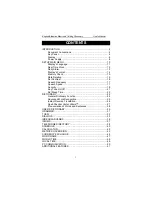
Using, Creating and Editing the
A
uto
Accompaniment Styles
Style Creator
PSR-S900/S700 Owner’s Manual
130
■
NTT (Note Transposition Table)
This sets the note transposition table for the source pattern.
■
NTT BASS ON/OFF
The channels for which this is set to ON will be played back by the bass root note,
when the on-bass chord is recognized by the instrument.
■
HIGH KEY
This sets the highest key (upper octave limit) of the note transposition for the chord
root change. Any notes calculated to be higher than the highest key are transposed
down to the next lowest octave. This setting is available only when the NTR param-
eter (page 129) is set to “Root Trans.”
BYPASS
When NTR is set to ROOT FIXED, the transposition table used does not
do any note conversion. When NTR is set to ROOT TRANS, the table
used only converts the root note.
MELODY
Suitable for melody line transposition. Use this for melody channels
such as Phrase 1 and Phrase 2.
CHORD
Suitable for chord transposition. Use this for the Chord 1 and Chord 2
channels, especially when they contain piano or guitar-like chordal
parts.
MELODIC MINOR
When the played chord changes from a major to a minor chord, this
table lowers the third interval in the scale by a semitone. When the
chord changes from a minor to a major chord, the minor third interval is
raised by a semitone. Other notes are not changed. Use this for melody
channels of Sections which respond only to major/minor chords, such
as Intros and Endings.
MELODIC MINOR
5th
In addition to the Melodic Minor transposition above, augmented and
diminished chords affect the 5th note of the Source Pattern.
HARMONIC
MINOR
When the played chord changes from a major to a minor chord, this
table lowers the third and sixth intervals in the scale by a semitone.
When the chord changes from a minor to a major chord, the minor
third and flatted sixth intervals are raised by a semitone. Other notes are
not changed. Use this for chord channels of Sections which respond
only to major/minor chords, such as Intros and Endings.
HARMONIC
MINOR 5th
In addition to the Harmonic Minor transposition above, augmented and
diminished chords affect the 5th note of the Source pattern.
NATURAL MINOR
When the played chord changes from a major to a minor chord, this
table lowers the third, sixth and seventh intervals in the scale by a
semitone. When the chord changes from a minor to a major chord, the
minor third, flatted sixth and flatted seventh intervals are raised by a
semitone. Other notes are not changed. Use this for chord channels of
Sections which respond only to a Major/minor chord such as Intros and
Endings.
NATURAL MINOR
5th
In addition to the Natural Minor transposition above, augmented and
diminished chords affect the 5th note of the Source pattern.
DORIAN
When the played chord changes from a major to a minor chord, this
table lowers the third and seventh intervals in the scale by a semitone.
When the chord changes from a minor to a major chord, the minor
third and flatted seventh intervals are raised by a semitone. Other notes
are not changed. Use this for chord channels of Sections which respond
only to a Major/minor chord such as Intros and Endings.
DORIAN 5th
In addition to the Dorian transposition above, augmented and dimin-
ished chords affect the 5th note of the Source pattern.
CM
C3-E3-G3
FM
F3-A3-C4
F
#
M
F
#
2-A
#
2-C
#
3
C
#
M
C
#
3-F3-G
#
3
Example — When the highest key is F.
Root changes
Notes played
















































